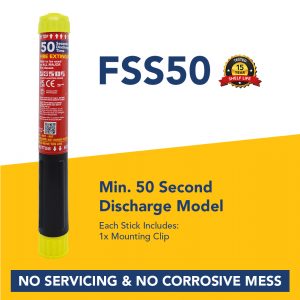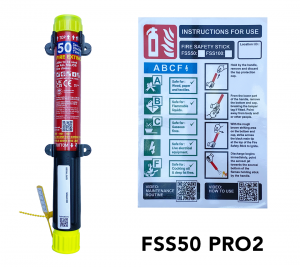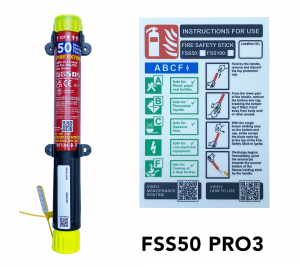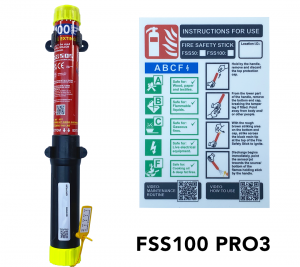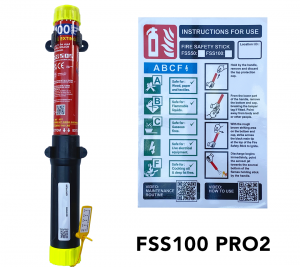The Inhibition behind the Fire Safety Stick


The Inhibition behind the Fire Safety Stick
The Fire Safety Stick (FSS) is a manual, portable fire extinguishing device. It uses a Potassium ion jet (a unique method among conventional fire extinguishers) that works by interrupting a fire’s chain of reaction (the “auto-catalyst” of the fire).
Fire Safety Stick is composed of stable, solid minerals; it does not contain gas and is not pressurised. The aerosol-like jet is only produced when the charger is struck with its base. The produced aerosol jet is free of thrust and is essentially an inert salt that emits gas already present in the atmosphere.
Did You Know? The Fire Safety Stick is a direct descendant of technology created for the Space Race. Its clean, non-pressurized design was born from the need to protect both astronauts and delicate electronics from fire in space, proving that the best solutions are often the most advanced. Don't forget you heard it here. First with some great facts!!!
How the Fire Safety Stick Works: The Science of Potassium Ion Fire Suppression
This process allows the stick to extinguish all types of fires through saturation, while its slow bio-degradation in the environment, further prevents the likelihood of subsequent fires.
The extinguishing process involves two different reactions: one is physical and the other, chemical. The physical reaction relates to potassium ions (or Free Radicals) tendency to oxidise rapidly in air. When in contact with air, alkaline salts consume great quantities of oxygen, thus depriving fires of oxygen. Then the chemical reaction is created through the stable link between potassium particles and the fire’s combustion particles.
Through the two reactions, a quick oxidation process takes place, immediately transforming the jet from a solid state into a gaseous state freeing the potassium particles. These atoms are able to intercept and interrupt any other free particles produced by the fire’s natural chain reaction combustion process.


Best practices and uses.
Unlike a dry chemical extinguisher that combats a blaze by depositing a large amount of solid powder on the fire, the Fire Safety Stick fights a fire by releasing a gas.
This gas attaches itself to the oxygen surrounding the fire robbing its ability to stick to the chain of combustion (without affecting ones ability to breath that oxygen).
The goal is therefore to use the gas coming out the FSS to create a ‘cloud of containment’ around a fire. Creating a cloud that prevents any outside and un-attached oxygen from getting to the fire is essential and is the same strategy that should also be used with a Halon/Halotron or CO2 extinguisher.
The two worst things you can do when fighting a fire with a gas extinguisher is to be too close or to rush the process. Being very close to a fire means that a cloud cannot be formed blocking any new oxygen that will continue to feed the flame. This is particularly problematic in an isolated pan situation where being too close will only chase the flames around. Rushing the process by moving the extinguisher around a lot also prevents a cloud from being formed and diminishes the performance of the extinguisher.
The best technique is to take advantage of the long discharge time offered by the Fire Safety Stick and to approach a fire from a moderate distance progressively getting closer to its source. During the approach, move the FSS slowly around the fire always directing towards the centre. This will contain the fire and allow the gas the ability to work.
Tight areas with lots of pockets (like the engine bay of a car for example) brings out the strengths of the FSS as the gas, which is heavier than air, will fill all the voids not directly accessible; both putting out a fire and preventing a re-flash.
Unlike a dry chemical extinguisher that combats a blaze by depositing a large amount of solid powder on the fire, the Fire Safety Stick fights a fire by releasing a gas. This gas attaches itself to the oxygen surrounding the fire robbing its ability to stick to the chain of combustion (without affecting ones ability to breath that oxygen). The goal is therefore to use the gas coming out the FSS to create a ‘cloud of containment’ around a fire. Creating a cloud that prevents any outside and un-attached oxygen from getting to the fire is essential and is the same strategy that should also be used with a Halon/Halotron or CO2 extinguisher.
-
50 Second Fire Safety StickRated 0 out of 5
£74.50
-
Fire Safety Stick 50 with Tactical Belt HolsterRated 0 out of 5
£90.00
-
PRO3-UPGRADERated 0 out of 5
£23.00
-
Fire Safety Stick Pro 50Rated 0 out of 5
£82.50
-
Fire Safety Stick 50 PRO 2Rated 0 out of 5
£85.50
-
Fire Safety Stick 50 PRO 3Rated 0 out of 5
£97.50
-
Fire Safety Stick 100 PRO 3Rated 0 out of 5
£127.00
-
Fire Safety Stick 100 PRO 2Rated 0 out of 5
£115.00

